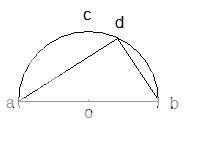The response that you've already received correctly states that there is no way to know the area of triangle ABD at this point; you'd need some more information. Frankly, that's probably all you wanted!

However, let me add a couple things to this discussion, just in case.
First, a diagram, just to give these things handles:

Thus, line AB is a diameter of the circle with center O, point D is arbitrarily chosen on the circle, and C is straight "up" from the middle (not rigorous, but you know what I mean).
You are correct in saying that ADB must be a right angle, regardless of where D is chosen.
1) There is no lower bound on the area of triangle ADB. If we "push" point D further and further and further to the right, the triangle gets shorter and shorter, see? Thus, the area of triangle ADB can get arbitrarily close to zero.
2) There is, however, an upper bound on the area of triangle ADB! Namely, \(r^2\). When point D coincides with point C, we create a nice 45-45-90 triangle, and visual inspection seems to indicate that it has the maximum area. (the formula is easy to work out: the base of the triangle is the diameter, which is 2r, and the height would then equal r. Thus, \((1/2) * b * h = (1/2) * 2r * r = r^2\)
We can also get that result analytically: Since we're building off of the diameter, the Base of the triangle is fixed. Thus, in order to maximize area, what should you do? Ah, let's maximize the other variable: the Height. And how do you do that? By putting the height right in the middle where it has the most "headroom", so to speak.
Enjoy!





